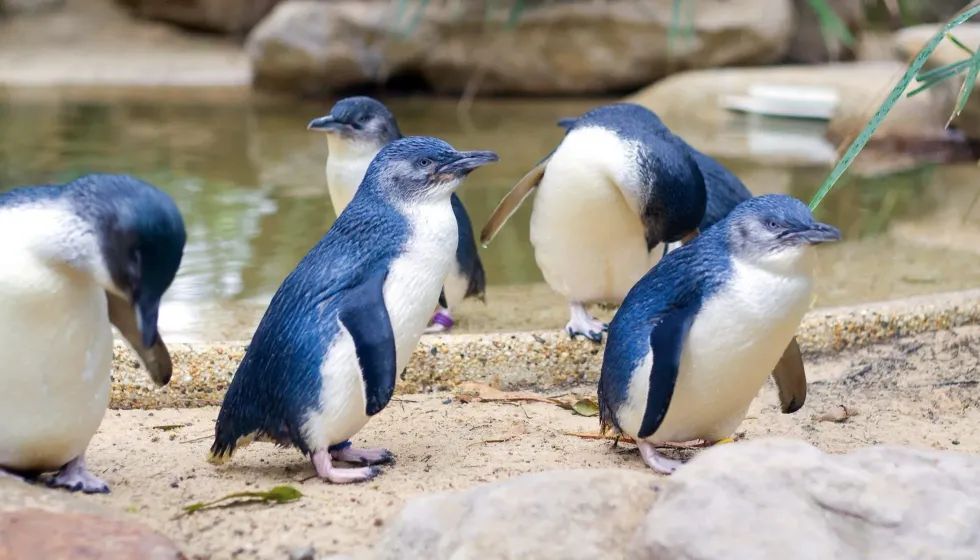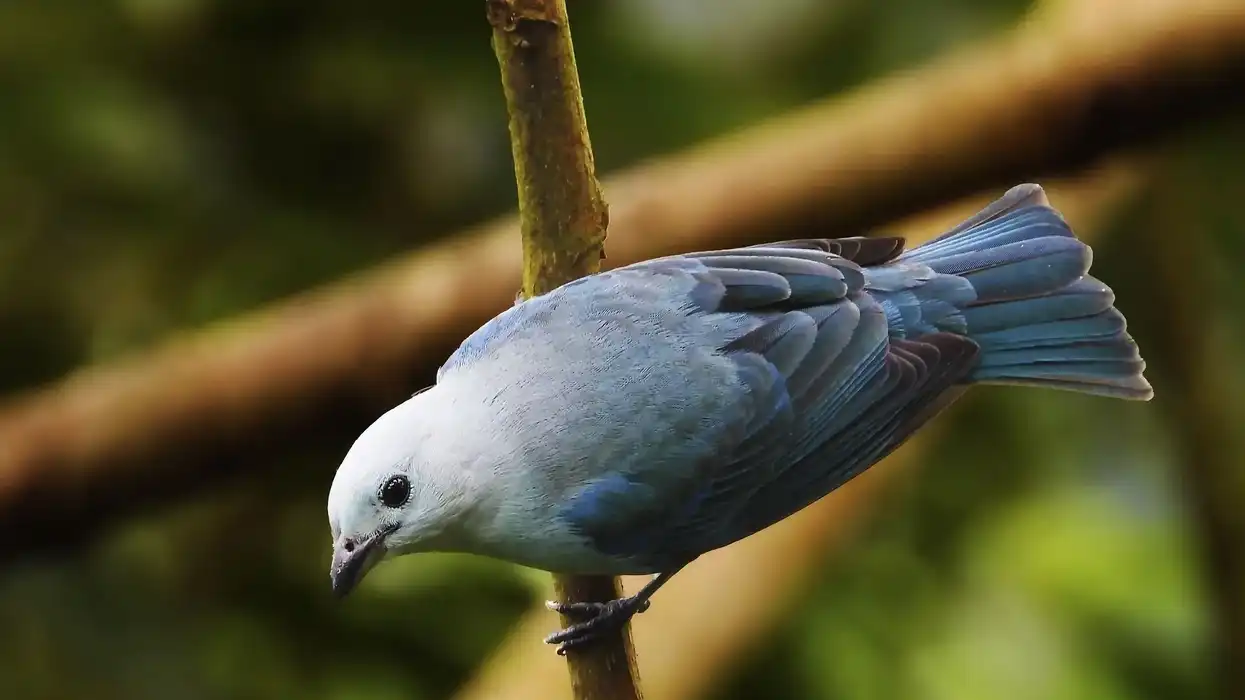The smallest penguin species, the little penguin (Eudyptula minor), belongs to the family of Spheniscidae. The average length and height of the little penguin are 10-11 in (25-27.9 cm) and 12-13 in (30-33 cm), respectively. The species weigh around 3-3.3 lb (1.36-1.5 kg).
People also refer to the species like the fairy penguin or the little blue penguin. The plumage of the upper body, including the head, is blue.
The eyes are gray or hazel, while the plumage in portion from chin to belly is white. The little blue penguin also possesses a tiny dark gray-black beak of 1.1-1.5 in (3-4 cm). Little blue penguins are monogamous, and the female fairy penguin lays around 1-2 eggs in each season.
The species is primarily endemic to the coastline of Australia and New Zealand. New South Wales, Jervis Bay Territory, Tasmania, the southern coast of Victoria in Australia are the primary sites where the little penguins are found, while in New Zealand, one can spot the penguin on Montunau Island.
The species has also been spotted in Chili and South Africa. The little penguin is carnivorous and primarily preys on fishes, octopuses, cuttlefish or crustaceans.
The penguin species have been listed in the Least Concern category by the International Union for Conservation of Nature. Cats, dogs, and wild foxes are believed to be the major predators of the species.
Keep on reading to learn more exciting facts about the little blue penguin. If you want to know more exciting information about different animals, check out these prairie falcon facts and ring-necked duck facts.
Little Blue Penguin Interesting Facts
What type of animal is a little blue penguin?
The little penguin (Eudyptula minor) is a seabird. Fairy penguin and little blue penguin are the other names of the little penguins. Little penguins are primarily found in Australia and New Zealand.
What class of animal does a little blue penguin belong to?
The little penguin belongs to the class of Aves of the Spheniscidae family and the genus of Eudyptula.
How many little blue penguin are there in the world?
The little penguin species can easily be spotted in New Zealand and Australia, and according to a statistic of 2011, the population of the little penguins was between 350,000-600,000. But the population of the little penguins has been declining for a few decades in New Zealand.
It is believed that the population of little penguins would not be more than 1,000,000 as of now. The main reason for their decline is human interference and habitat loss.
Where does a little blue penguin live?
The little penguin (Eudyptula minor) can easily be found on the coastline of Australia and New Zealand. New South Wales, Jervis Bay Territory, Tasmania, the southern coast of Victoria, and offshore islands in Australia are the primary sites where little penguins are found.
In New Zealand, one can spot the penguin on Montunau Island. The species has also been spotted in Chili and South Africa.
What is a little blue penguin's habitat?
Breeding pairs are generally found in the coastal regions with better nesting conditions. They also inhabit scrub forests, savanna. The caves even serve as the habitat of the little penguins.
Who do little blue penguin live with?
Most little penguins are solitary, while some prefer to live in pairs or small groups. The group or raft consists of not more than six little blue penguins. These little blue penguins are nocturnal, and the rafts are generally seen during nights near the nesting areas.
How long does a little blue penguin live?
Little blue penguins live for an average of 6.5 years. Recently, a banded fairy penguin with the age of more than 25 years was spotted.
How do they reproduce?
Little blue penguins are monogamous, which means the breeding pair remains the same. The breeding season differs geographically, but usually, the breeding season occurs from July to December.
The male little blue penguins reach sexual maturity after three years and two years for females. After attaining sexual maturity, the little penguins perform several courtship displays to attract each other. The displays mainly involve emitting braying sounds, standing still and heads upright facing the sky.
Male little blue penguins perform the courtship displays either alone or in a small colony. Also, the breeding takes place in a loose colony.
After choosing the partner, the female fairy penguins perform the same display, after which they get involved in copulation. The fairy penguins choose ground burrows as their nesting sites. The penguin species also prefer the caves and rock crevices as nesting sites.
The incubation period lasts for around 31-40 days, and the female lays about 1-2 eggs in each season. The pairs take care of their offspring or chicks and save them from predators.
These penguin chicks weigh around 0.08-0.10 lb (36-47 g). These penguin chicks generally live for more than 60 days with their parents. After the guard period, the chicks weigh around 1.7-2.5 lb (800-1150 g).
What is their conservation status?
The International Union for Conservation of Nature has listed the animals in the Least Concern category. Over the years, the populations are declining in New Zealand and a few islands of Australia. The major cause of the decline is human interference, plastic pollution, oil spills, habitat loss, tourism are the major threats to the populations of the species.
Little Blue Penguin Fun Facts
What do little blue penguin look like?
You can see the upper body plumage is blue, the eyes are gray or hazel, while the feathers from chin to belly are white. They also have a dark gray-black sharp beak that grows to 1.1-1.5 in (3-4 cm) long.
The beak is primarily used to feed the chicks and while fighting the other penguins and predators. These smart penguins are majorly found on the coastlines of Australia and New Zealand.
How cute are they?
A major source of attraction in New Zealand and Australia, these tiny-sized penguins are the cutest animals. The fascinating thing about these animals is the courtship displays that the males perform in a colony to attract the female penguins. Also, the walk of their chicks would be so delightful to watch and walk on land.
How do they communicate?
Like other species of birds, the little blue penguin uses the same methods of communication such as touch, sense of smell, and many more. Also, each member of the family has a different sound.
The sound of the calls could be harsh or light. The birds also use courtship displays to allure each other. They also become quite aggressive to protect their chicks during the arrival of predators.
How big is a little blue penguin?
As the smallest species of penguin, the little blue penguin is 10-11 in (25-27.9 cm) long and 12-13 in (30-33 cm) tall. These penguins are ten times the weight of white-faced stormed petrels, one of the most beautiful seabirds. Emperor penguins are thrice the size of the little blue penguins.
How fast can a little blue penguin swim?
These birds could easily reach the speed of 1.6 mph (2.5 km/h).
How much does a little blue penguin weigh?
These tiny-sized blue penguins weigh around 3-3.3 lb (1.36-1.5 kg) while the weight of their chicks is around 1.7-2.5 lb (800-1150 g) after 50-60 days of birth.
What are the male and female names of the species?
People generally use cock and hen to refer to the male and female penguin respectively. The beaks of the male penguins are generally longer compared to females.
What would you call a baby little blue penguin?
The babies of little blue penguins are called chicks.
What do they eat?
These animals are carnivores and they primarily prey on small fish, anchovies, sea horse, octopuses, cuttlefish or crustaceans.
Are they dangerous?
Generally, the little penguins are not believed to be dangerous or deadly to humans but they could turn violent if someone tries to harm them. These nocturnal animals are quite aggressive to their predators.
Would they make a good pet?
Unlike other birds, penguins would be the most difficult pets. A proper habitat, surroundings need to be maintained before keeping them as pets.
But the most concerning thing is the reduction of the population. Over the decades, the population of the species has been decreasing rapidly, and keeping them as pets would not be allowed. Legal permission is required for keeping them as pets.
Did you know...
Apart from the names such as the fairy penguin and little blue penguin, the species is also known as korora in the native language.
The Phillip Island of Australia is the largest colony of little penguins, with more than 32,000 breeding pairs.
The Iron Baron oil spill off Tasmania and the Rena oil spill off Tauranga, New Zealand, are the major oil spill events that affected a huge population of the species.
The little blue penguins are seabirds and they do have well-adapted wings. The penguins can not fly but use their flippers while swimming.
How many little blue penguins are left in New Zealand?
For a few decades, the population of the little blue penguins has been declining in New Zealand. According to the figures, more than 60% of the marine population has declined. The numbers would be between 50,000-100,000.
Is the little blue penguin the smallest penguin?
Yes, the little blue penguin is the smallest penguin species, but the species are also the smartest among all. The species are known for walking long distances.
Here at Kidadl, we have carefully created lots of interesting family-friendly animal facts for everyone to discover! For more relatable content, check out these pileated woodpecker facts and common buzzard facts for kids.
You can even occupy yourself at home by coloring in one of our free printable Little blue penguin coloring pages.










